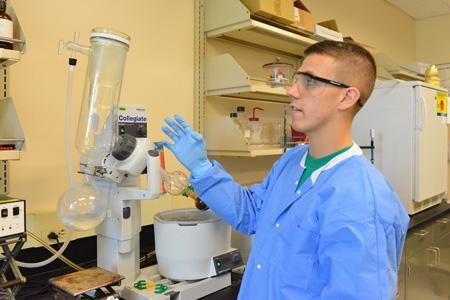VMI Cadet Researches Element Synthesis

Owen Ahrens ’24 conducts research on the synthesis and reactivity of cobalt-centered molecules in the lab at VMI.—VMI Photo by Marianne Hause.
LEXINGTON, Va., June 27, 2022—Imagine getting diagnosed with cancer and being told the one medicine that treats the cancer is extremely expensive because the natural sources that produce the anticancer compound are not sufficient to meet the demand. This is an all too true scenario, and as a result, chemists have researched ways to develop compounds synthetically in order to improve their availability and make them more economical. At Virginia Military Institute, Owen Ahrens ’24 is researching the synthesis and reactivity of cobalt-centered molecules in his Summer Undergraduate Research Institute (SURI) project titled, “Synthesis and Utilization of Alkyl Cobaloxime Complexes in Cycloaddition Reactions.”
Ahrens, who is majoring in biology with a minor in chemistry, chose the project for several reasons. He wanted to work with Maj. Kaitlyn Cartwright, assistant professor in chemistry. Her specialty is chemical methodology, and she is working with cobaloximes this summer. “Ever since I had Major Cartwright for general chemistry, I knew I wanted to work with her research,” said Ahrens. He also enjoys working in the laboratory and wants to improve his lab skills, as he plans on pursuing a career in medicine. In addition, he is passionate about serving others and hopes his research will aid in discovering ways to synthesize medicines.
Cobalt, an element found in the Earth’s crust, has the potential to be extremely functional in chemical methodology. It is most commonly used in batteries, aircraft engine parts, dyes, and in the treatment of cancer. “I want to stretch the limits on how to use cobalt,” said Ahrens. “There is a cobalt complex that mimics vitamin B-12. I believe we can go much farther with other cobalt complexes.”
Cartwright, who shares Ahrens excitement in researching cobalt said, “This is Ahrens first research experience, and he has really enjoyed learning all the different technical skills that come along with working in a chemistry laboratory and that will translate into future employment. He has been building cobalt-based scaffolds in order to use them to help facilitate chemical synthesis.” She continued, “A scaffold refers to the construction or framework. Owen is building molecules, like microscopic architecture. Each different scaffold is like a different floor plan for a house, and different floor plans are optimal for different purposes. His project right now is building a type of scaffold, and systematically modifying one component on the structure to see how it influences the function of the scaffold. Currently, he has found that electronic influences of the portion of the scaffold he changes greatly influences the reactivity of the structure. What he is still working on is how to take advantage of this reactivity change to achieve the desired reaction. He is enthusiastic about continuing to explore this chemistry over the next several weeks.”
Ahrens, who is from Lynchburg, Virginia, is a VMI legacy. His father, David Ahrens ’91 encouraged his children to attend VMI. “Dad good-naturedly teased us about coming to VMI, but there was no pressure. Ever since I was in the eighth grade, I knew I wanted to come to VMI. There was no other place I wanted to attend,” stated Ahrens, whose younger brother, Noah is also a member of the Class of 2025. “We’re hoping our sister joins us here in the fall of 2023. It would be so much fun for all three of us to be here at once.”
Ahrens, who looks for ways to help others, serves as an EMT (emergency medical technician) on post. “It is so fulfilling to me to be involved with the Rat Line and teach them about taking care of themselves and keeping them safe during physical training. I want to invest in my brother rats and try to make an impact during my time at VMI,” said Ahrens.
Upon graduating from VMI, Ahrens plans to continue his education in a physician’s associate program.
Marianne Hause
Communications & Marketing
VIRGINIA MILITARY INSTITUTE
.svg)
.png)